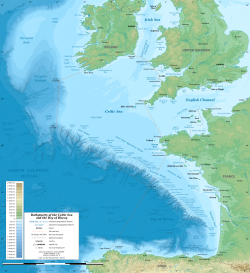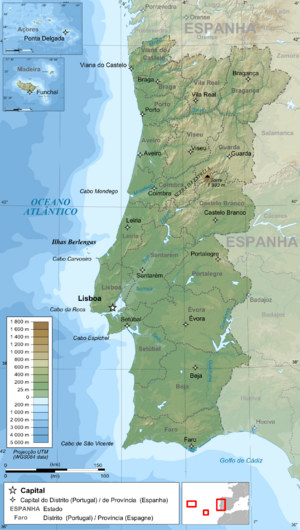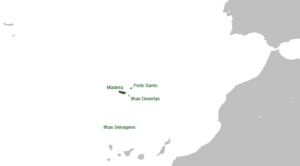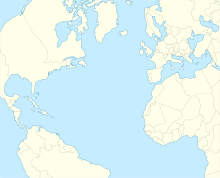Convoy HG 76 facts for kids
Quick facts for kids Convoy HG 76 |
|||||||
|---|---|---|---|---|---|---|---|
| Part of Second World War | |||||||
 Map of the Bay of Biscay and the South-western Approaches |
|||||||
|
|||||||
| Belligerents | |||||||
| Commanders and leaders | |||||||
| Karl Dönitz | Sir Raymond Fitzmaurice Frederic John Walker |
||||||
| Strength | |||||||
| Wolfpack Seeräuber 10 U-boats |
HG 76 32 merchant ships 24 escorts |
||||||
| Casualties and losses | |||||||
| 5 U-boats destroyed | 2 merchant ships sunk 2 escorts sunk |
||||||
Convoy HG 76 was a group of Allied ships traveling together for safety during World War II. This convoy, which sailed from Gibraltar to Britain between December 19 and 23, 1941, became famous for a big victory against German U-boats (submarines). The British managed to sink five U-boats, though they didn't know the exact number until after the war.
During this journey, two German Condor planes, used for finding ships, were shot down by British Martlet fighter planes. These fighters came from a special ship called HMS Audacity, which was an escort carrier. Sadly, the Audacity was sunk during the battle, along with a destroyer and two merchant ships. Even with these losses, this battle was seen as the first major victory for the Allies in the long Battle of the Atlantic.
Contents
Why This Battle Was Important
The attack on Convoy HG 76 was one of the last in a series of U-boat attacks on convoys sailing from Gibraltar. These attacks had started in the summer of 1941. Before this, Germany's U-boat force (called the U-bootwaffe) mostly focused on convoys in the North Atlantic.
By mid-1941, Germany had more U-boats. This allowed them to form several "patrol lines" to hunt convoys. At the same time, Adolf Hitler ordered U-boats to the Mediterranean Sea to help German forces there and attack ships near Gibraltar.
For the Allies, creating stable escort groups helped them develop better ways to protect convoys. They learned that air cover was very important to spot enemy planes and U-boats. They also needed more ships to hunt and destroy U-boats, not just scare them away.
The British introduced new measures for this battle. One was the Audacity, the first of its kind, which was a merchant ship converted into a small aircraft carrier. This ship provided air cover. They also added more escort ships and formed a special anti-submarine warfare (ASW) group at Gibraltar. This group would search ahead of convoys to find and attack U-boats. All these new tactics were in place when HG 76 sailed.
Getting Ready for Battle
HMS Audacity Joins the Fight
The Audacity was an important part of the convoy's protection. It had eight Martlet fighter planes and ten pilots. These planes would fly patrols over the convoy, looking for U-boats and German Condor planes.
In November, before HG 76, the Audacity helped protect another convoy, OG 76. German Condor planes tried to find that convoy. The Audacity's radar spotted them, and Martlet fighters were sent out. They shot down one Condor, and another was damaged. This showed how useful the Audacity was. However, the Germans now knew about this new escort carrier.
Convoy HG 76 Sets Sail
Convoy HG 76 had 32 merchant ships heading home from Gibraltar. Many were empty or carrying trade goods. The convoy was led by Vice-Admiral R. Fitzmaurice. It had a very strong escort force. This included the 36th Escort Group, led by Commander F. J. "Johnnie" Walker. Walker was a very skilled expert in fighting submarines. His group had two sloops (smaller warships) and seven corvettes (even smaller warships).
The escort also included the new escort carrier Audacity and three destroyers. Several other sloops and corvettes joined them too. In total, there were 17 warships protecting the convoy. A special group of destroyers from Gibraltar also sailed ahead to hunt U-boats.
The German Seeräuber Wolfpack
Since 1940, German U-boat commander Karl Dönitz had changed how U-boats attacked. Instead of attacking alone, U-boats were told to find a convoy and then signal its position to other U-boats. When enough U-boats had gathered, Dönitz would order a "wolfpack" attack, usually at night. This allowed the U-boats to fire their torpedoes while on the surface.
German agents in Algeciras, Spain, could see the harbor in Gibraltar and report on ships leaving. In mid-December, German U-boat Command learned that a convoy was forming at Gibraltar. They quickly put together a wolfpack called Seeräuber (Pirate).
The Seeräuber group had seven U-boats at first. Five of these were larger Type IX boats, which Dönitz didn't think were best for wolfpack attacks. Also, five of the seven crews were new and on their first patrols. The wolfpack was ordered to sink the Audacity at all costs. Later, three more U-boats joined the group.
The Battle Begins
December 14–15
Convoy HG 76 left Gibraltar on December 14, 1941. German agents immediately reported its departure. The first U-boats to spot HG 76 were U-74 and U-77. However, British Fairey Swordfish planes from Gibraltar were protecting the convoy and drove off the U-boats.
The German Seeräuber U-boats formed a patrol line south of Cape St Vincent, but HG 76 passed through without being seen. On December 15, British Lockheed Hudson and Catalina planes took over from the Swordfish. They worked with the Audacity's Martlet fighters, forcing U-boats to stay underwater. Later that day, a British Short Sunderland plane spotted U-127. The next morning, HMAS Nestor detected U-127 with its sonar (Asdic) and sank it.
December 16–18
On December 16, a German Condor plane spotted HG 76 and guided U-108 to the convoy. That night, the wolfpack moved closer. By the morning of December 17, four U-boats had found the convoy.
Just after 9:00 a.m., a Martlet from Audacity saw a U-boat on the surface. A British corvette tried to attack it. Later, at 12:47 p.m., Stanley spotted U-131 on the surface. Commander Walker ordered a Martlet to attack. The Martlet pilot dived towards the U-boat, and both fired. The Martlet was shot down, and the pilot was killed. British ships then opened fire, forcing U-131 to the surface, where it was sunk. Survivors from U-131 said they had been shadowing the convoy and guiding other U-boats.
On the night of December 17–18, the U-boats attacked again but didn't hit any ships. On December 18, Stanley found U-434 with its sonar. Several ships dropped many depth charges. After 30 minutes, U-434 surfaced, and its crew abandoned the ship before it sank north of Madeira. 42 crew members were rescued and taken prisoner.
Later that day, Martlets from Audacity tried to intercept two Condor planes, but their guns jammed. The Condors escaped. The British Admiralty warned that three more U-boats were on their way. In the early hours of December 19, Stanley spotted U-574. Stanley was then hit by a torpedo and exploded. HMS Stork, following behind, quickly found U-574 with its sonar and dropped depth charges.
A U-boat shot to the surface, and Commander Walker tried to ram it with Stork. The U-boat was very quick, but Stork managed to ram it near its conning tower (the tower on top of the submarine). As the U-boat came out from under Stork's stern, shallow-set depth charges were dropped, blowing up the U-boat. The front of Stork was damaged. Soon after, U-108 torpedoed the merchant ship Ruckinge, which was later sunk. German Condor planes arrived, and one was shot down. Another Condor was destroyed when a Martlet pilot, in a very brave head-on attack, actually collided with it.
December 19–21

On the morning of December 19, a Condor appeared, but a Martlet chased it away. In the afternoon, a Martlet spotted two U-boats, and the convoy made an emergency turn. The U-boats were forced to submerge, and Martlets kept them down.
By December 21, the wolfpack had been joined by more U-boats, including U-71, U-567, and U-751. The Audacity's Martlet pilots were very tired, and only three planes were still working. The commander of Audacity ordered the ship to move about 10 miles away from the convoy, as was normal practice, but no escorts could be spared to go with it.
At 8:33 p.m. on December 21, a ship at the back of the convoy was torpedoed by U-751. Nearby ships fired flares, lighting up the area. U-567 saw the outline of Audacity nearby and, at 8:37 p.m., torpedoed it. The Audacity began to sink from the back. Two more torpedoes from U-751 hit the carrier, causing a huge explosion that blew off its front. The ship then began to sink from the front. Audacity sank head first at 10:10 p.m., about 500 miles west of Cape Finisterre.
December 22–23
At 12:40 a.m. on December 22, U-567 was sunk by depth charges from Deptford. Deptford then accidentally collided with Stork, damaging both ships.
During December 22, U-71 and U-751 stayed in contact with the convoy. HG 76 was reinforced by two more destroyers, HMS Vanquisher and Witch. At 10:54 a.m., a Liberator plane from RAF Nutts Corner in Ireland arrived over the convoy and chased away a German Condor. The Liberator attacked a U-boat and was later replaced by a second Liberator, which forced three more U-boats to submerge.
By December 23, the convoy was within range of constant air support. Karl Dönitz, the German U-boat commander, was upset by the loss of five U-boats and the lack of success against the convoy. He called off the attack, and the remaining U-boats returned to their bases in France.
What Happened Next
Even though the Audacity and three other ships were lost, the safe arrival of 30 merchant ships and the destruction of five U-boats was considered a huge victory for the Allies. This battle also confirmed Commander Walker as the Royal Navy's top expert in fighting submarines. The loss of five U-boats, including U-567 and its experienced commander, Engelbert Endrass, was a big blow to the Germans.
Ships Involved in the Battle
Allied Ships
Convoy HG 76 included 32 merchant ships and 17 warships.
Merchant Ships
Here are some of the merchant ships that were part of Convoy HG 76:
| Name | Flag | Tonnage (GRT) | Notes |
|---|---|---|---|
| Adjutant (1922) | 1,931 | ||
| Algerian (1924) | 2,315 | ||
| Annavore (1921) | 3,324 | Sunk by U-567 | |
| Baron Newlands (1928) | 3,386 | ||
| Empire Darwin (1941) | 6,765 | A special ship that could launch a fighter plane | |
| Ruckinge (1939) | 2,869 | Sunk by U-108 | |
| Spero (1922) | 1,589 | The lead ship for the convoy |
Convoy Escorts
Many military ships protected the convoy during its journey. Here are some of them:
| Name | Flag | Type | Joined | Left |
|---|---|---|---|---|
| HMS Audacity (D10) | Escort carrier | 14 Dec 1941 | Sunk by U-751 on 21 Dec 1941 | |
| HMS Black Swan (L57) | Sloop | 14 Dec 1941 | 16 Dec 1941 | |
| HMS Blankney (L30) | Destroyer | 14 Dec 1941 | 18 Dec 1941 | |
| HMS Convolvulus (K45) | Corvette | 14 Dec 1941 | 30 Dec 1941 | |
| HMS Deptford (U53) | Sloop | 14 Dec 1941 | Collided with HMS Stork on 22 Dec 1941 | |
| HMS Stanley (I73) | Destroyer | 14 Dec 1941 | Sunk by U-574 on 19 Dec 1941 | |
| HMS Stork (L81) | Sloop | 14 Dec 1941 | Collided with HMS Deptford on 22 Dec 1941 |
Axis Forces
The German Seeräuber (Pirate) group was formed on December 14, 1941, with seven U-boats. It was later joined by three more. Five U-boats were destroyed during the battle.
| Number | Type | Navy | Contact | Notes |
|---|---|---|---|---|
| U-67 | IXC | Kriegsmarine | 14 December 1941 | |
| U-71 | VIIC | Kriegsmarine | 21 December 1941 | Joined later |
| U-107 | IXB | Kriegsmarine | 14 December 1941 | |
| U-108 | IXB | Kriegsmarine | 14 December 1941 | Sank Ruckinge |
| U-127 | IXC | Kriegsmarine | 14 December 1941 | Sunk 15 December by Nestor |
| U-131 | IXC | Kriegsmarine | 14 December 1941 | Sunk 17 December by Stork, Penstemon and a Martlet plane |
| U-434 | VIIC | Kriegsmarine | 14 December 1941 | Sunk 18 December by Stanley |
| U-567 | VIIC | Kriegsmarine | December 1941 | Joined later; Sank Annavore; Sunk 21/22 December by Deptford |
| U-574 | VIIC | Kriegsmarine | 14 December 1941 | Sank Stanley; Sunk 19 December by Stork |
| U-751 | VIIC | Kriegsmarine | December 1941 | Joined later; Sank Audacity |





